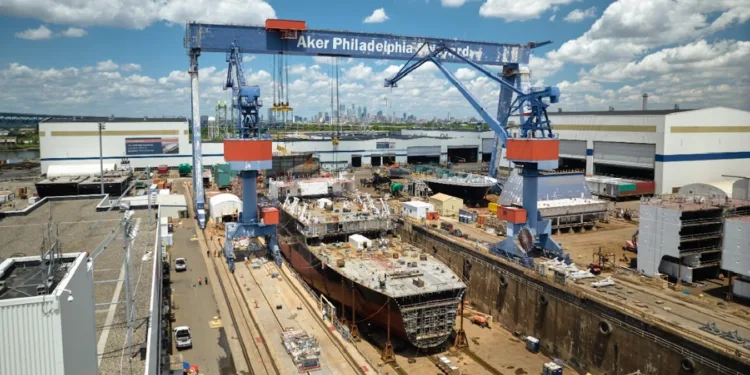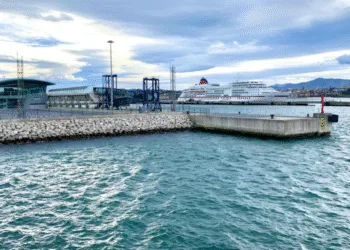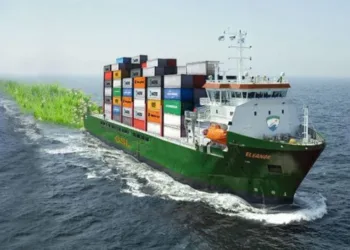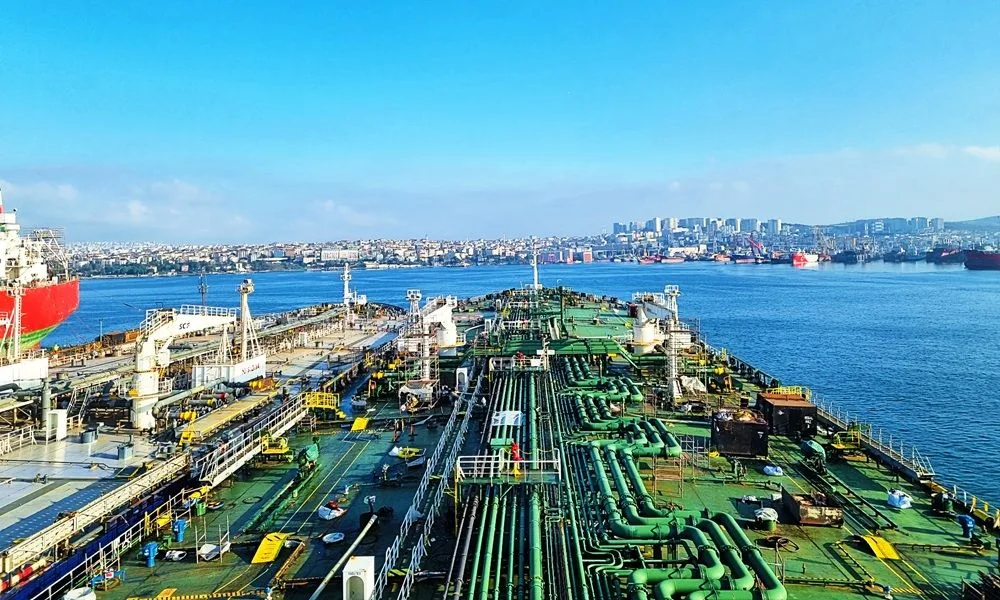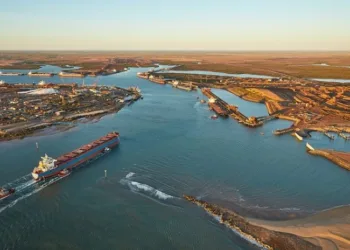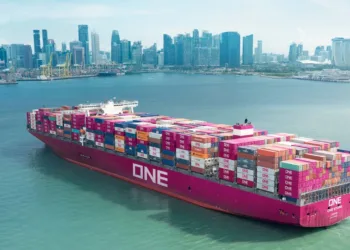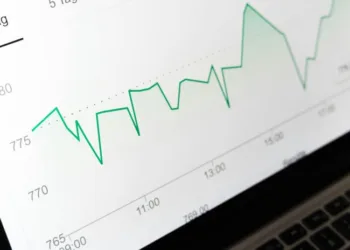WASHINGTON — As the immediate former chairman of the Federal Maritime Commission-turned-lobbyist, Louis Sola has a unique perspective on the Trump administration’s initiative to revitalize the U.S. maritime sector.
The former Army intelligence officer and megayacht entrepreneur backs the plan to build up a domestic commercial fleet and reverse the decline of American shipyards. But he also sees the necessity of addressing the support structure of such far-reaching proposals — and possible unintended consequences.
Solas will be a featured speaker at F3: Future of Freight Festival, Oct. 21-22 in Chattanooga.

“I definitely want to see more U.S.-flag ships, but I think there’s nothing better than having U.S.-built ships,” he said in an interview over lunch at a Washington hamburger bistro. “But it’s very restrictive on being built in the United States, being crewed by the United States and being owned by U.S. operators. And I think, eventually, that ends up hurting our exports, since our export industry is much larger than the shipbuilding industry.
“With the personnel that we put into [shipping], it’s a long-term aspect that we need to definitely invest into our maritime sector like we’ve never done before, we need better maritime academy grads coming out, and we need to promote that, too.”
Solas, who was nominated to the FMC in 2020 by President Trump and re-nominated by President Biden, led efforts to stabilize supply chains, alleviate port congestion, and enhance U.S. competitiveness in global shipping. His crisis leadership during the Covid pandemic garnered bipartisan acclaim, and he oversaw vital reforms impacting ocean carriers, ports, and intermodal logistics.
There’s another harsh reality, Sola said, that could hamper a shipbuilding renaissance.
“A lot of the yards don’t want to do commercial work, they only want to do Department of Defense work, and the reason is is because it might get paid better or longer,” he said. “I’ve had people come to me and say, “Hey, I would like to do ship repair, but I can’t get a yard that’s open because they’re waiting for DoD work or they don’t want to put put us up on the drydock, and then get a call from DoD a month later that you know, we need to put you down”. So I think we really need to start with ship repair.”
That might seem like so much, uh, water under the bridge when assessing the ability of U.S. shipyards to compete in the global market.
“The Chinese the Koreans and the Japanese are all subsidized, one way or another, whether it’s on labor, whether it’s on the raw materials or the steel that they get,” said Sola. “But what they’ve done, which we have not accomplished yet, is we need to make the Model T, we need to find our niche as a country that’s something that we build overwhelmingly well, and we’re able to mass produce it. Whether it’s a car carrier, or it’s a container ship, or whatever. Right now, there’s a lot of shipping restrictions being put on [foreign-built] LNG [liquefied natural gas] exports, and we don’t make any LNG carriers.
“But we’re not going to be competitive in the first five or first 10 hulls that we produce. We’re going to be competitive on hulls 19 or 20, but it takes a lot of investment to get that far. This is not a five-year fix, we need to have a 15-year horizon on that.”
[Soon after this interview, the shipping division of South Korean conglomerate Hanwha announced an order for 10 LNG tankers, to be built at Hanwha’s shipyard in Philadelphia.]
The long-term commitment is only the first step. Said Sola, “We also need to get the personnel. Do we have enough welders, do we have enough skilled technicians? I think certain areas definitely have an advantage. Pennsylvania has a great shipbuilding opportunity, plenty of raw materials. They have a lot of good labor and so do the Gulf states, for example, Texas, Louisiana, Mississippi, Alabama.
“My home state of Florida has great potential to specialize in barges but there needs to be a long-term vision on how to get there. I think that if we can combine DoD with commercial…a lot of vessels that are built for the Department of Defense, such as tankers and other types, if we can make those of a more commercial aspect, maybe we could be able to mass produce some of them.”
While Sola said he saw military tankers under construction in San Diego and civil-defense type ships in Louisiana, the nature of defense contracting doesn’t lend itself to the commercial market.
“Where a commercial contract is probably 1,000 pages, a Navy contract is thousands of pages, and then they have program managers, and they have other type of things. Coast Guard and Navy vessels are so cumbersome, you could have overheads at 30% or 40% or up to sometimes 50% on some of these DoD vessels. Do we really need so many program managers on a 100-foot Coast Guard cutter that we double the cost of the vessel — exactly the same as a commercial vessel being delivered to the port authority of New York-New Jersey? So, I think we really need to look at that.”
At the same time, Sola believes it’s critical that shipyards target customers where they’ll have a realistic chance of gaining market share due to vessel prices that aren’t competitive with those of Asia builders.
“I don’t think that market is the trans-Pacific, maybe we should start off with Caribbean traffic or Central American traffic — the countries there are trading partners — where you can have 4,000- or 5,000-TEU container vessels right now,” he said. “I know they’re building three of those in Philadelphia, we have a 3,000-TEU container vessel being built in Pennsylvania at double the price of a 20,000-TEU container vessel built in Asia.
“The price can’t be five times as much or six times as much or seven times as much [as Asia], so shipbuilding has a lot of obstacles to overcome. The economy of scale just isn’t there yet.”
The key? “John D. Rockefeller said, “The secret of success is to do the common thing uncommonly well,”” said Sola. “A Model T ship that can be mass-produced produced, that’s the only way that we’re going to be able to compete in ships.”
Beyond shipbuilding, the Trump administration has also taken aim at China’s growing dominance of global shipping. The United States Trade Representative earlier this year proposed a slate of fees effective in October on Chinese-built and -operated cargo ships meant to make calling at U.S. ports prohibitively expensive. A recent report by investment bank HSBC said the fees could cost Cosco and Orient Overseas Container Line as much as $1.5 billion in 2026.
“I understand the need to counter China’s influence in shipping where they’ve definitely taken a lead around the world,” Sola said, “but I don’t believe that it should happen at the expense of the U.S. exporter, especially if the goods are going back to China. I believe in free trade between nations and trade flowing between the United States and China has happened for hundreds of years. If the Chinese would like to send their goods here and then bring U.S. goods back on a Chinese ship, I believe that they should have the ability to do that.”
As some observers feared, the port fees have led carriers to reconfigure trade routes to avoid U.S. gateways, calling ports in Canada and Mexico where goods can be transshipped to their U.S. destinations.
“That’s another major point that I made when I was FMC chairman, a lot of goods are bypassing the northwest sea passage [to the U.S. Pacific Northwest] and they’re going to the port of Prince Rupert [in western Canada], and what that does, it’s avoiding the Harbor Maintenance Tax [which helps fund port infrastructure]. And then those goods are coming in by truck and rail, and I believe that if we were able to clear customs at a seaport and all those goods were, you know, treated the same, whether they came in through the northwest sea passage, or they went in through Prince Rupert, they would still have to pay the HMT regardless of the tariffs and other charges. Because you see reports up in Seattle and Tacoma, their cargo volumes are going down, they’re withering, and they’re losing good-paying jobs and the culprit of that is 100% the diversion of cargo that’s going to Canada.”
Sola foresees that same thing happening with the Port of Ensenada in Mexico.
“I think our two southern California ports are the most efficient and best that we have in the entire nation, and we need to protect that national security interest.”
Any discussion of the Port of Los Angeles-Long Beach leads to the subject of railroads. BNSF and Union Pacific provide inland transportation for containers arriving at the San Pedro gateway, and Sola cheered UP’s proposed acquisition of eastern carrier Norfolk Southern, which would create the nation’s first freight-only transcontinental railroad.
“I think it’s a fantastic opportunity for the supply chain in general,” he said. “When I was at the FMC, I bet half of the complaints that we got were railroad-related or about handoffs between ports and railroads. The idea that we can shave a day or two off of cargo moving from the West Coast to the East Coast, or even to the Midwest, I believe it’s going to be absolutely astounding the efficiencies that we’re going to have. That being said, we’re dealing with a duopoly here that we really need to watch in the future, to make sure that there isn’t any price-gouging and other type of effects from the railroads.”
Sola believes a merger will extend the national rail network’s reach, with distribution arteries extending to more places than before — a plus for importers and exporters.
Sola said that he expects the Surface Transportation Board and chairman Patrick Fuchs will do “a great job” analyzing the merger.
“They’re going to make sure that all the T’s are crossed, all the periods are put in the right place, and that there is complete oversight on this as they go forward.”
Find more articles by Stuart Chirls here.
Related coverage:
Container mishap shuts down Port of Long Beach pier
New ‘green’ report for Port of Long Beach on-dock rail
Dubai’s DP World to develop Montreal container terminal
Earnings growth outlook ‘bleak’ as ocean shipping profits plunge 56% in Q2
The post Ex-FMC chief warns: U.S. maritime push needs deeper look appeared first on FreightWaves.



